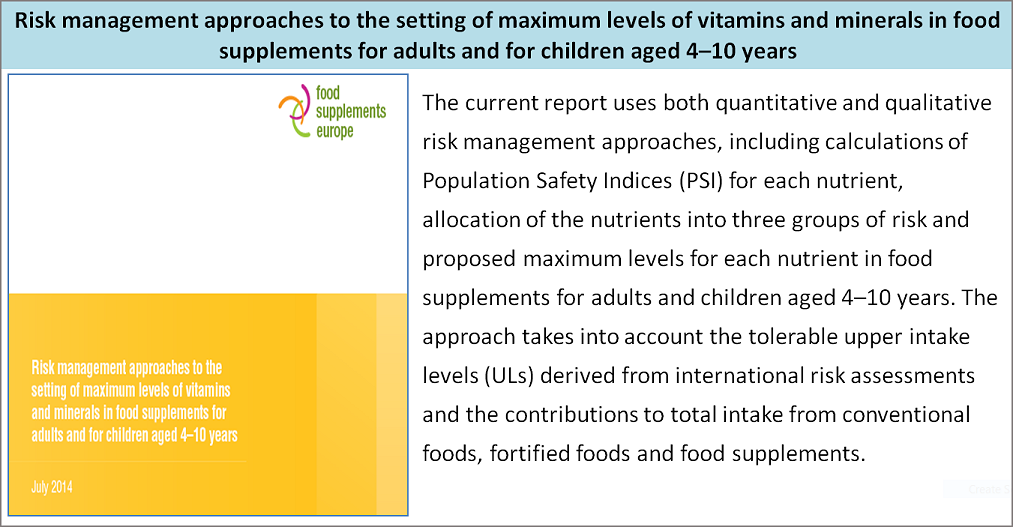Each nutrient has a particular function in the human body, and a balanced diet provides adequate amounts of all necessary nutrients to maintain health and well-being. The amount of each individual nutrient needed to maintain an individual's health is called the nutrient requirement. Nutrient requirements vary depending on age and gender, level of physical activity, physiological status (such as pregnancy), dietary habits and genetic background. Dietary reference values (DRVs) for Vitamins (more 2.1.5) and (DRVs) for Minerals (more 2.1.6) are quantitative reference values for nutritional intakes derived for different population groups, based on health criteria. They are used for the estimation of quantities of energy and nutrients needed to support adequate growth, development and health, while reducing the risk of deficiencies and non-communicable diseases. DRVs are developed for different life-stages and gender groups, and for different age ranges, depending on the available data. Within any population group, nutrient requirements vary between individuals. DRVs are intended for healthy people. Those who suffer from diseases may have different needs. Health professionals provide guidance to individuals or groups with specific needs. DRVs were set in the EU Food Information for Consumers Regulation 1169/2011, and are also used as the basis for information on food labels and for establishing dietary guidelines, to help consumers make healthy dietary choices. In Europe, terminology has been harmonised and EFSA used the following set of defined DRVs.
- Population Reference Intake: level of intake adequate for virtually all people, i.e. an optimal intake for the population as a whole.
- Average Requirement: level of intake adequate for half of the people, assuming a normal distribution of requirements.
- Lower Threshold Intake: level of intake below which, on the basis of current knowledge, almost all individuals would have an inadequate intake.
- Adequate Intake (when evidence is insufficient to set a Population Reference Intake): the average level of a nutrient consumed by healthy populations (i.e. assumed to be adequate).
Since DRVs not only aim to ensure sufficient intakes of essential nutrients, but also guard against over-consumption, the following reference values also exist:
- Reference intake ranges for macronutrients: expressed as a proportion of daily energy intakes, to reflect intakes that are adequate for maintaining health and are associated with a low risk of chronic disease. For example, the reference intake range set for dietary fat is 20-35% of total daily energy intake.
- Tolerable Upper Intake Level (or Upper Level): the maximum level of chronic daily intake of nutrients unlikely to have adverse health effects
Dietary intakes can be estimated and assessed against DRVs to determine whether diets are at risk of inadequate, or indeed excessive, intakes of nutrients. These values guide professionals on the amount of a nutrient needed to maintain health in an otherwise healthy individual or group of people. In the next Table 2.1.2. is presented an EFSA's extended report on different Dietary Reference Values (DRVs) for nutrients.

Regulatory authorities around the world need to ensure that levels of micronutrients in the total diet are safe, and that the cumulative intake from all sources does not lead to excessive intakes and any adverse effects in the population, including sensitive groups such as children, the elderly and women during pregnancy and lactation. Major physiological changes in the velocity of growth and in endocrine status occur during childhood and adolescence. The onset of puberty is an extremely anabolic period that is influenced by a marked rise in hormonal activity, which results in a number of physical changes that characterize adolescence. Although most nutraceuticals currently used are known vital nutrients for the human body, many details such as dose, drug-drug interaction, nutraceutical-drug interaction, and their effects on individuals under certain health conditions remain elusive. In the next Table 2.1.3. is presented scientific opinion of EFSA on the tolerable Upper intake level of EPA, DHA, DPA.

Increasing knowledge from food chemistry, nutritional and clinical studies is providing more insight into our understanding of biological functions, usage and potential adverse effects of nutritional elements.
There are three major and complementary ways of delivering the essential micronutrients for human health and well-being:
- by promoting the consumption of nutrient-dense foods
- by increasing the availability and intake of foods with added nutrients (fortified foods)
- by the appropriate use of food (dietary) supplements
However, it is necessary to ensure that levels of micronutrients in the total diet are safe and that the cumulative intake from all sources does not lead to excessive intakes and any adverse effects.
The Population Reference Intakes (PRIs), also called Recommended Daily Allowances (RDAs), are based on the principle that most, if not all, individuals of a population or a specific population group should obtain an adequate nutrient intake to satisfy their requirements. Such recommended values are generally based on the principle of the average requirement plus two Standard Deviations (SD) for the nutrient in the population group. In 1992 an SCF opinion on nutrient and energy intakes for the European Community3 defined the PRIs for several nutrients. These values were mainly determined on the basis of the concept of optimal nutrition which implied that these values were determined among other, to prevent deficiencies, to optimize body stores and to reduce the risk of diseases.
Risk analysis for nutrients differs from other substances in foods because vitamins and minerals are essential for life, and consequently adverse effects can result from suboptimal intakes and deficiencies as well as from excessive intakes. Risk analysis comprises three distinct but closely linked components: risk assessment, risk management and risk communication.
The quantitative and qualitative risk management approaches described in this report attempt to address the many difficulties, limitations and inconsistencies surrounding the establishment of ULs, particularly for children e.g. the limited nutrient intake data from conventional foods, fortified foods and food supplements, the uncertainties and biases in the estimation of habitual nutrient intake distributions and the care needed not only to address the risk of excessive intakes but also the risk of suboptimal intakes and micronutrient deficiencies in vulnerable groups.
The Food Supplements Europe society published in July 2014 an extensive report on Risk management approaches to the setting of maximum levels of vitamins and minerals in food supplements for adults and for children aged 4-10 years presented in the next Table 2.1.4.

Obtaining adequate nutrients from various foods plays a vital role in maintaining normal function of the human body. New concepts have appeared, such as nutraceuticals, nutritional therapy, and these functional or medicinal foods play positive roles in maintaining well being, enhancing health, and modulating immune function to prevent specific diseases






